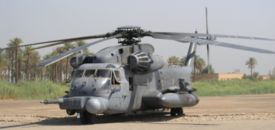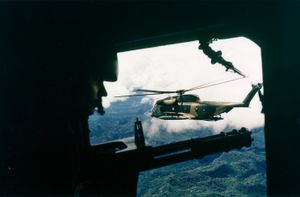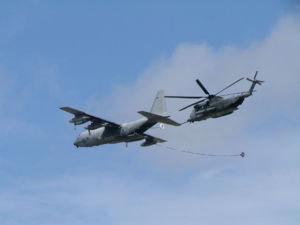PlaneSpottingWorld welcomes all new members! Please gives your ideas at the Terminal.
Sikorsky HH-53/MH-53
| HH-53 "Super Jolly Green Giant" MH-53 Pave Low | |
|---|---|
| MH-53M In Iraq, Summer 2004 | |
| Type | Heavy-lift helicopter |
| Manufacturer | Sikorsky Aircraft |
| Status | Active |
| Primary user | United States Air Force |
| Unit cost | MH-53J: US$40 million (2001 dollars) |
| Developed from | CH-53 Sea Stallion |
The Sikorsky HH-53 "Super Jolly Green Giant" is a USAF version of the CH-53 Sea Stallion helicopter for long-range combat search and rescue (CSAR) helicopters. It was developed to replace the HH-3 "Jolly Green Giant"". The HH-53s were later upgraded as MH-53 Pave Low series.
The USAF MH-53J/M fleet is scheduled for retirement, effective 1 October, 2008.[1]
Contents
Development
The US Air Force ordered HH-53B and HH-53C variants for Search and Rescue units, and developed the MH-53J Pave Low version for Special Operations missions.
The Pave Low's mission is low-level, long-range, undetected penetration into denied areas, day or night, in adverse weather, for infiltration, exfiltration and resupply of special operations forces. Pave Low's often work in conjunction with MC-130H Combat Talon for navigation, communications and combat support,[2] and with MC-130P Combat Shadow for inflight refueling.[3][4]
Although officially known as the Stallion, the large green airframe of the HH-53B earned it the nickname "Super Jolly Green Giant." This name is a reference to the smaller HH-3E "Jolly Green Giant", a stretched variant of the H-3 Sea King, used in the Vietnam War for combat search-and-rescue (CSAR) operations.
HH-53B
The US Air Force liked their Sikorsky S-61R/HH-3E "Jolly Green Giant" long-range combat search and rescue (CSAR) helicopters very much, and so were very interested in the more capable S-65. In 1966, the USAF awarded a contract to Sikorsky for development of a minimum-change CSAR variant of the CH-53A.[5]
The HH-53B, as it was designated, featured:
- A retractable inflight refueling probe on the right side of the nose.
- Spindle-shaped jettisonable external tanks with a capacity of Template:Converta, fitted to the sponsons and braced by struts attached to the fuselage.
- A rescue hoist above the right passenger door, capable of deploying a jungle penetrator on Template:Converta of steel cable.
- Armament of three pintle-mounted General Electric GAU-2B/A 7.62 millimeter (.308 in) six-barreled Gatling-type miniguns, with one in a forward hatch on each side of the fuselage and one mounted on the tail ramp, with the gunner secured with a harness.
- A total of Template:Converta of armor.
- A Doppler navigation radar in the forward belly.
- Early HH-53Bs featured T64-GE-3 turboshafts with Template:Converta, but these engines were later upgraded to T64-GE-7 turboshafts with Template:Convert. Five crew were standard, including a pilot, copilot, crew chief, and two pararescuemen.[5]
While waiting for delivery of the HH-53Bs, the Air Force obtained two Marine CH-53As for evaluation and training. The first of eight HH-53Bs performed its initial flight on 15 March 1967, and the type was performing CSAR missions with the USAF Aerospace Rescue & Recovery Service in Southeast Asia by the end of the year. The Air Force called the HH-53B the "Super Jolly". It was used for CSAR, covert combat operations, and "snagging" reentry capsules from photo-reconnaissance satellites.[5]
HH-53C
The HH-53B was essentially an interim type, with production quickly moving on to the modestly-improved Air Force HH-53C CSAR variant. The most visible difference between the HH-53B and HH-53C was that the HH-53C dispensed with the fuel-tank bracing struts. Experience with the HH-53B showed that the original tank was too big, adversely affecting performance when they were fully fueled, and so a smaller Template:Converta tank was adopted in its place. Other changes included more armor and a more comprehensive suite of radios to improve communications with C-130 tankers, attack aircraft supporting CSAR actions, and aircrews awaiting rescue on the ground. The HH-53C was otherwise much like the HH-53B, with the more powerful T64-GE-7 engines.[5]
A total of 44 HH-53Cs was built, with introduction to service in August 1968. Late in the war they were fitted with countermeasures pods to deal with heat-seeking missiles. As with the HH-53B, the HH-53C was also used for covert operations and snagging reentry capsules, as well as snagging reconnaissance drones. A few were assigned to support the Apollo space program, standing by to recover an Apollo capsule in case of a launchpad abort, though such an accident never happened.[5]
In addition to the HH-53Cs, the Air Force obtained 20 CH-53C machines for more general transport work. The CH-53C was apparently very similar to the HH-53C, even retaining the rescue hoist, the most visible difference being that the CH-53C did not have an inflight refueling probe. Since CH-53Cs were used for covert operations, they were no doubt armed and armored, just like HH-53Cs.[5]
The Super Jollies made headlines in November 1970 in the unsuccessful raid into North Vietnam to rescue prisoners-of-war from the Son Tay prison camp, as well as in the operation to rescue the crew of the freighter SS Mayagüez from Cambodian Khmer Rouge fighters in May 1975. The Air Force lost 17 Super Jollies in the conflict, with 14 lost in combat – including one that was shot down by a North Vietnamese MiG-21 on 28 January 1970 while on a CSAR mission over Laos – and three lost in accidents.[5]
The HH-53B, HH-53C, and CH-53C remained in Air Force service into the late 1980s. Super Jollies operating in front-line service were painted in various camouflage color schemes, while those in stateside rescue service were painted in a natty overall gray scheme with a yellow tailband. A good number of Super Jollies were converted into Pave Low special-operations machines, the subject of the next section.[5]
HH/MH-53H
Template:Inappropriate tone The USAF's Super Jollies were good helicopters and appreciated by the service, but they were more or less daylight / fair weather machines, and downed aircrew were often in trouble at night or in bad weather. A limited night / foul weather sensor system designated Pave Low I based on a low-light-level TV (LLLTV) imager was deployed to Southeast Asia in 1969 and combat-evaluated on a Super Jolly, but it left much to be desired in terms of reliability.[5]
In 1975, an HH-53B was fitted with the much improved Pave Low II system and re-designated YHH-53H. This exercise proved much more satisfactory, and so eight HH-53Cs were given a further improved systems fit and redesignated HH-53H Pave Low III, with the YHH-53H also upgraded to this specification. All were delivered in 1979 and 1980. Two of the HH-53Hs were lost in training accidents in 1984, and so two CH-53Cs were brought up to HH-53H standard as replacements.[5]
The HH-53H retained the inflight refueling probe, external fuel tanks, rescue hoist, and three-gun armament of the HH-53C; armament was typically a minigun on each side, and a Browning 12.7 millimeter gun in the tail to provide more reach and a light anti-armor capability. The improvements featured by the HH-53H included:
- A Texas Instruments AN/AAQ-10 forward-looking infrared (FLIR) imager.
- A Texas Instruments AN/APQ-158 terrain-following radar (TFR).
- A Canadian Marconi Doppler-radar navigation system.
- A Litton or Honeywell inertial guidance system (INS).
- A computerized moving-map display.[5]
- A radar-warning receiver (RWR) and chaff-flare dispensers.
The FLIR and TFR were mounted on a distinctive "chin" mount. The HH-53H could be fitted with 27 seats for troops or 14 litters. The upgrades were performed by the Navy in Pensacola, reflecting the fact that the Navy handled high-level maintenance on Air Force S-65s. In 1986, the surviving HH-53Hs were given an upgrade under the CONSTANT GREEN program, featuring incremental improvements such as a cockpit with blue-green lighting compatible with night vision goggles (NVGs). They were then reclassified as "special operations" machines and accordingly given a new designation of "MH-53H".[5]
The HH-53H proved itself and the Air Force decided to order more, coming up with an MH-53J Pave Low III Enhanced configuration. The general configuration of the MH-53J is similar to that of the HH-53J, the major change being fit of twin T64-GE-415 turboshafts with 4,380 SHP (3,265 kW) each, as well as more armor, giving a total armor weight of 1,000 pounds (450 kilograms). There were some avionics upgrades as well, including fit of a modern Global Positioning System (GPS) satellite navigation receiver. An assortment of 31 HH-53Bs, HH-53Cs, and CH-53Cs were upgraded to the MH-53J configuration from 1986 through 1990, with all MH-53Hs upgraded as well, providing a total of 41 MH-53Js.[5]
MH-53J/M
The MH-53J Pave Low III heavy-lift helicopter is the largest, most powerful and technologically advanced transport helicopter in the US Air Force inventory. The terrain-following and terrain-avoidance radar, forward looking infrared sensor, inertial navigation system with Global Positioning System, along with a projected map display enable the crew to follow terrain contours and avoid obstacles, making low-level penetration possible.
Under the Pave Low III program, the Air Force modified nine MH-53Hs and 32 HH-53s for night and adverse weather operations. Modifications included forward-looking infrared, inertial navigation system, global positioning system, Doppler navigation systems, APQ-158 terrain-following and terrain-avoidance radar, an on-board mission computer, enhanced navigation system, and integrated avionics to enable precise navigation to and from target areas. The Air Force designated these modified versions as MH-53Js.
The MH-53J's main mission is to drop off, supply, and pick up special forces who are behind enemy lines. It also can engage in combat search and rescue missions. Low-level penetration is made possible by a state-of-the-art terrain following radar, as well as infrared sensors that allow the helicopter to operate in bad weather.
This helicopter is equipped with armor plating. It can transport 38 troops at a time and sling up to 20,000 pounds (9000 kg) of cargo with its external hook. It reaches top speeds of 165 mph (266 km/h) and altitudes up to 16,000 feet (4900 m).
The MH-53M Pave Low IV is a MH-53 J-model, that has been modified with the Interactive Defensive Avionics System/Multi-Mission Advanced Tactical Terminal or IDAS/MATT. The system enhances present defensive capabilities of the Pave Low. It provides instant access to the total battlefield situation, through near real-time Electronic Order of Battle updates. It also provides a new level of detection avoidance with near real-time threat broadcasts over-the-horizon, so crews can avoid and defeat threats, and replan enroute if needed.
Variants
- TH-53A - training version used by US Air Force (USAF)
- HH-53B - CH-53A type for USAF search and rescue (SAR)
- CH-53C - heavy-lift version for USAF, 22 built
- HH-53C - "Super Jolly Green Giant", improved HH-53B for USAF
- S-65C-2 (S-65o) - export version for Austria, later to Israel
- S-65-C3 - export version for Israel
- YHH-53H - prototype Pave Low I aircraft
- HH-53H - Pave Low II night infiltrator
- MH-53H - redesignation of HH-53H
- MH-53J - "Pave Low III" special operations conversions of HH-53B, HH-53C, et al.
- MH-53M - "Pave Low IV" upgraded MH-53Js
For other variants, see CH-53 Sea Stallion and CH-53E Super Stallion.
Specifications (MH-53J)
Template:Aircraft specification
Popular culture
The MH-53M Pave Low IV is featured in the 2007 Transformers film as the alternate mode of Blackout. Production designer Jeff Mann stated "the Pave Low looks butch... the size made it the logical choice."[6]
References
- ↑ Last Bolt: Final wrench turns to end an era USAFE News. Retrieved on 29 December, 2007.
- ↑ MC-130E/H Combat Talon I/II Fact Sheet, US Air Force.
- ↑ MC-130P Combat Shadow Fact Sheet, US Air Force.
- ↑ MH-53J page, Globalsecurity.org
- ↑ 5.00 5.01 5.02 5.03 5.04 5.05 5.06 5.07 5.08 5.09 5.10 5.11 5.12 Greg Goebel's Vectorsite
- ↑ "The Making Of The Transformers Movie - Production Design: The Robots, The Vehicles, The Sets", ENI, 2007-06-15. Retrieved on 2007-09-13.
The initial version of this article was based on a public domain article from Greg Goebel's Vectorsite. This article contains information that originally came from a US Government website, in the public domain. USAF Website
External links
- MH-53J/M USAF fact sheet
- MH-53PaveLow.com, the unofficial Pave Low web site
- HH-53, MH-53J Pave Low III, and MH-53M Pave Low IV pages on GlobalSecurity.org
Related content
Related development
Comparable aircraft
Designation sequence
- U.S. Military:
- Sikorsky:
Related lists
See also
Template:Sikorsky Aircraft
Lists relating to aviation | |
|---|---|
| General | Timeline of aviation · Aircraft · Aircraft manufacturers · Aircraft engines · Aircraft engine manufacturers · Airports · Airlines |
| Military | Air forces · Aircraft weapons · Missiles · Unmanned aerial vehicles (UAVs) · Experimental aircraft |
| Notable incidents and accidents | Military aviation · Airliners · General aviation · Famous aviation-related deaths |
| Records | Flight airspeed record · Flight distance record · Flight altitude record · Flight endurance record · Most produced aircraft |




